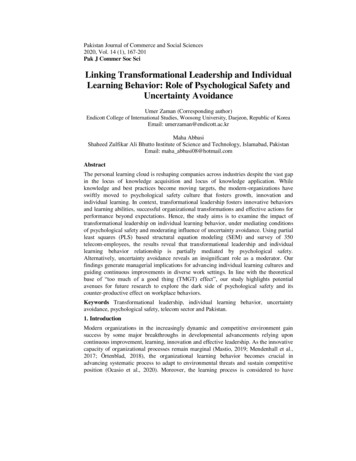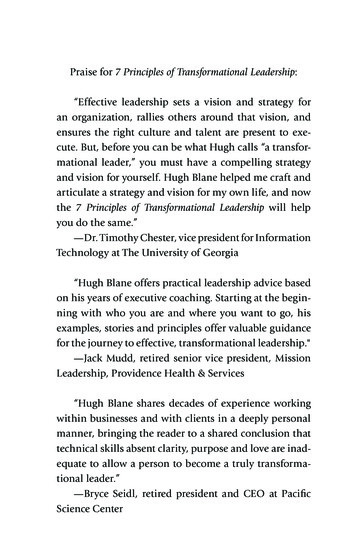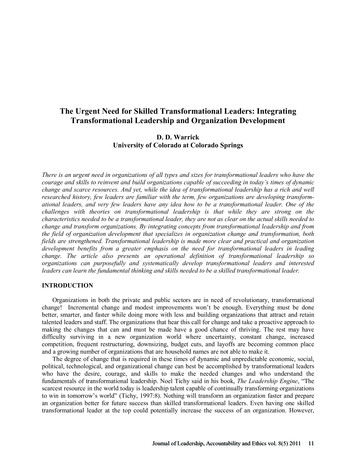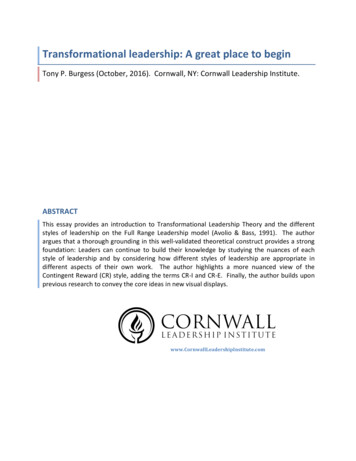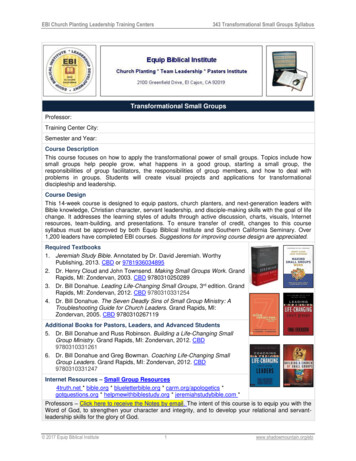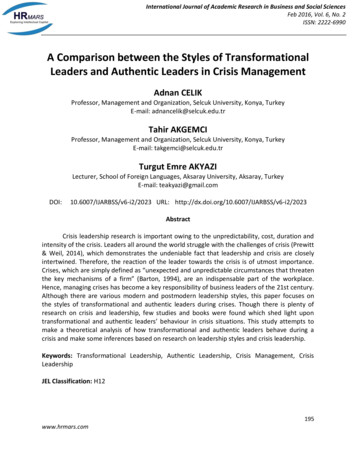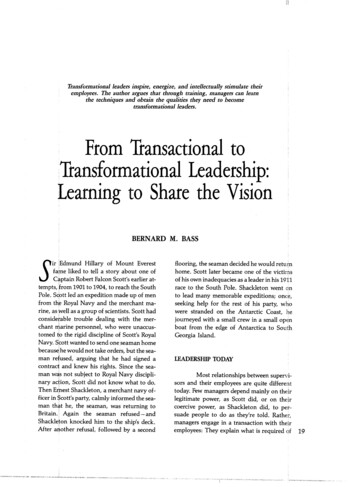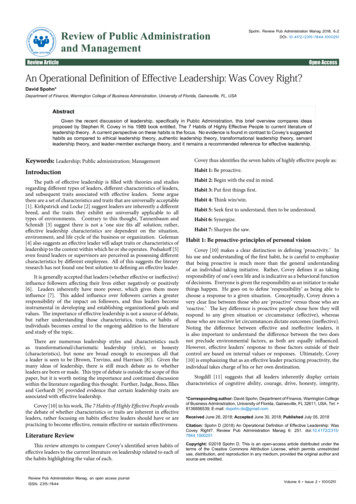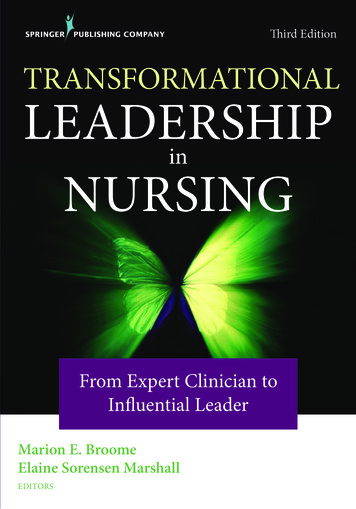
Transcription
Third EditionTRANSFORMATIONALLEADERSHIPinNURSINGFrom Expert Clinician toInfluential LeaderMarion E. BroomeElaine Sorensen MarshallEDITORS
Register Now for Online Accessto Your Book!Your print purchase of Transformational Leadership in Nursing, Third Edition,includes online access to the contents of your book—increasing accessibility,portability, and searchability!Access today -0-8261-3505-6or scan the QR code at the right with your smartphoneand enter the access code below.3K3DWF6LIf you are experiencing problems accessing the digital component of this product, please contact ourcustomer service department at cs@springerpub.comThe online access with your print purchase is available at the publisher’s discretion and may beremoved at any time without notice.Scan here forquick access.Publisher’s Note: New and used products purchased from third-party sellers are not guaranteed forquality, authenticity, or access to any included digital components.SPCView all our products at springerpub.com
Marion E. Broome, PhD, RN, FAAN, is dean of the School of Nursing, vicechancellor for nursing affairs, and Ruby Wilson Professor of Nursing at DukeUniversity, as well as associate vice president for academic affairs for nursing at Duke University Health System, Durham, North Carolina. Prior to joining Duke, Dr. Broome was dean of the Indiana University School of Nursingand associate vice president for nursing at Indiana University Health, whereshe was awarded the rank of distinguished professor. Widely regarded asan expert, scholar, and leader in pediatric nursing research and practice, Dr.Broome was funded externally by the American Cancer Society, the NationalInstitutes of Health, and various foundations for two decades. Dr. Broome’sresearch is published in more than 121 papers in 58 nursing, medicine, andinterdisciplinary journals. She also has published seven books and 20 chapters.Dr. Broome is editor in chief of Nursing Outlook, the official journal of theAmerican Academy of Nursing and the Council for the Advancement ofNursing Science. She completed a variety of leadership training courses whileserving in the Army Nurse Corp, a Management and Leadership in EducationCertificate from Harvard University, and the Center for Creative Leadership’sLeading for Organizational Leadership Course.Elaine Sorensen Marshall, PhD, RN, FAAN, is former Castella DistinguishedProfessor and chair of the Department of Health Restoration and Care SystemsManagement at the University of Texas Health Science Center School of Nursing,San Antonio, Texas; former professor and Bulloch Endowed Chair at the Schoolof Nursing at Georgia Southern University, Statesboro, Georgia; and professorand dean emerita of the College of Nursing at Brigham Young University, Provo,Utah. She has served in national elected and appointed leadership positions forthe American Association of Colleges of Nursing, the American Association forthe History of Nursing (AAHN), and the Western Institute of Nursing (WIN).Dr. Marshall has published two books and more than 50 articles and bookchapters. She received the New Professional Book Award from the NationalCouncil on Family Relations, the Lavinia Dock Award from the AAHN, and theJo Eleanor Elliott Leadership Award from the WIN.
TRANSFORMATIONALLEADERSHIP IN NURSINGFrom Expert Clinician to Influential LeaderThird EditionMarion E. Broome, PhD, RN, FAANElaine Sorensen Marshall, PhD, RN, FAANEditors
Copyright 2021 Springer Publishing Company, LLCAll rights reserved.No part of this publication may be reproduced, stored in a retrieval system, or transmitted in any form orby any means, electronic, mechanical, photocopying, recording, or otherwise, without the prior permissionof Springer Publishing Company, LLC, or authorization through payment of the appropriate fees to theCopyright Clearance Center, Inc., 222 Rosewood Drive, Danvers, MA 01923, 978-750-8400, fax 978-646-8600,info@copyright.com or on the Web at www.copyright.com.Springer Publishing Company, LLC11 West 42nd StreetNew York, NY .com/homeAcquisitions Editor: Adrianne BrigidoCompositor: Amnet SystemsISBN: 978-0-8261-3504-9ebook ISBN: 978-0-8261-3505-6Instructor’s PowerPoints ISBN: 978-0-8261-3542-1DOI: 10.1891/9780826135056Qualified instructors may request supplements by emailing textbook@springerpub.com20 21 22 23 24 / 5 4 3 2 1The author and the publisher of this Work have made every effort to use sources believed to be reliableto provide information that is accurate and compatible with the standards generally accepted at the timeof publication. The author and publisher shall not be liable for any special, consequential, or exemplarydamages resulting, in whole or in part, from the readers’ use of, or reliance on, the information containedin this book. The publisher has no responsibility for the persistence or accuracy of URLs for external orthird-party Internet websites referred to in this publication and does not guarantee that any content on suchwebsites is, or will remain, accurate or appropriate.Library of Congress Cataloging-in-Publication DataNames: Marshall, Elaine S., author, editor. Broome, Marion, author,editor.Title: Transformational leadership in nursing : from expert clinician toinfluential leader / Marion E. Broome, Elaine Sorensen Marshall.Description: Third edition. New York, NY : Springer Publishing Company,LLC, [2021] Author’s names reversed on the previous edition. Includes bibliographical references and index. Identifiers: LCCN 2019046706 (print) LCCN 2019046707 (ebook) ISBN9780826135049 (paperback) ISBN 9780826135056 (ebook) ISBN9780826135421 (Instructor’s PowerPoints)Subjects: MESH: Nurse Administrators Leadership Nursing, SupervisoryClassification: LCC RT89 (print) LCC RT89 (ebook) NLM WY 105 DDC362.17/3068—dc23LC record available at https://lccn.loc.gov/2019046706LC ebook record available at https://lccn.loc.gov/2019046707Contact us to receive discount rates on bulk purchases.We can also customize our books to meet your needs.For more information please contact: sales@springerpub.comPublisher’s Note: New and used products purchased from tird-party sellers are not guaranteed for quality,authenticity, or access to any included digital components.Printed in the United States of America.
CONTENTSContributors viiForeword Patricia Reid Ponte, DNSc, RN, FAAN, NEA-BC ixPreface xiPART I: CONTEXTS FOR TRANSFORMATIONAL LEADERSHIP1. Frameworks for Becoming a Transformational Leader 3Elaine Sorensen Marshall and Marion E. Broome2. Transformational Leadership: Complexity, Change, and StrategicPlanning 35Marion E. Broome and Elaine Sorensen Marshall3. Current Challenges in Complex Healthcare Organizationsand the Quadruple Aim 67Katherine C. Pereira and Margaret T. Bowers4. Practice Models: Design, Implementation, and Evaluation 99Mary Cathryn Sitterding, Christy Miller, and Elaine Sorensen Marshall5. Collaborative Leadership Contexts: It Is All About WorkingTogether 155Marion E. Broome and Elaine Sorensen MarshallPART II: BECOMING A TRANSFORMATIONAL LEADER6. Shaping Your Own Leadership Journey 183Marion E. Broome and Elaine Sorensen Marshall7. Building Cohesive and Effective Teams 213Marion E. Broome and Elaine Sorensen MarshallPART III: LEADING THE DESIGN OF NEW MODELS OF CARE8. Creating and Shaping the Organizational Environment andCulture to Support Practice Excellence 237Megan R. Winkler and Elaine Sorensen Marshallv
vi Contents9. Economics and Finance of Healthcare 277Brenda Talley10. Leading Across Systems of Care and in the Larger Community 319Marion E. Broome and Elaine Sorensen MarshallIndex345
CONTRIBUTORSMargaret (Midge) T. Bowers, DNP, RN, FNP-BC, AACC, FAANPAssociate ProfessorDuke University School of NursingDurham, North CarolinaMarion E. Broome, PhD, RN, FAANDean and Ruby Wilson Professor of NursingDuke University School of NursingVice Chancellor for Nursing Affairs, Duke UniversityAssociate Vice President for Academic Affairs for NursingDuke University Health SystemDurham, North CarolinaElaine Sorensen Marshall, PhD, RN, FAANCastella Distinguished Professor and Department Chair (retired)University of Texas Health Science Center School of NursingSan Antonio, TexasBulloch Endowed Chair (retired), School of Nursing, Georgia SouthernUniversityStatesboro, GeorgiaProfessor and Dean Emerita, College of Nursing, Brigham Young UniversityProvo, UtahChristy Miller, MSN, RN, CPNClinical Program ManagerCincinnati Children’s Hospital Medical CenterCincinnati, OhioKatherine C. Pereira, DNP, RN, FNP-BC, ADM-BC, FAAN, FAANPProfessorDirector, Doctor of Nursing Practice ProgramDuke University School of NursingDurham, North Carolinavii
viii ContributorsMary Cathryn Sitterding, PhD, RN, CNS, FAANVice President, Patient ServicesCenter for Professional ExcellenceCincinnati Children’s Hospital Medical CenterCincinnati, OhioBrenda Talley, PhD, RN, NEA-BCClinical Associate ProfessorThe University of Alabama in HuntsvilleHuntsville, AlabamaMegan R. Winkler, PhD, RN, CPNP-PCResearcher, Division of Epidemiology and Community HealthUniversity of Minnesota School of Public HealthMinneapolis, Minnesota
FOREWORDI am so pleased to be writing the foreword for the third edition of TransformationalLeadership in Nursing: From Expert Clinician to Influential Leader. As a seasonedhealth services nurse leader, I know much about the complexities and challenges of healthcare delivery, and I appreciate the importance of effective leadership in advancing excellence in this important domain.This book provides readers with a vibrant and up-to-date view of thesecomplexities and challenges. It imparts a plethora of knowledge, both theoretical and empirical, that positions readers to develop their own effectiveness aspeople and leaders so that they can ultimately positively influence healthcaredelivery in the future. This book is perfectly geared toward nurses who areinterested in becoming more effective and more influential people and leadersas they carry out their professional roles in healthcare delivery.When I first read the second edition of Transformational Leadership, I knewimmediately that this was the book I would use to teach nurses to be effectiveleaders. I recently transitioned from my health services role to teaching DNPstudents full time. I was designing the leadership course for a new DNP program and looking for just the right book. When I found the second edition, I wasimmediately taken with the usefulness of the entire book. Every chapter wasfilled with the content I knew I needed to prioritize for our new course.When I reached out to Marion Broome and Elaine Marshall about my interest in knowing if a third edition would be coming out soon, I was so delightedto hear that, in fact, the plan for that was well underway. Both Marion andElaine have incredible depth in their own expertise and experience in leadingin the academic setting. They could not be better suited to be editors for thisimportant text. That was evident to me as I read the second edition.In this current edition, a comprehensive overview of leadership theory setsthe stage in the first chapter, but it does not stop there. The book encouragesreaders to personalize the knowledge imparted in the book to their unique characters and roles in the healthcare setting. This book is written with applicationin mind. It highlights key challenges that leaders face and provides ideas andstrategies based in evidence that can guide their planning, implementing, andevaluating tactics and strategies to ensure excellence in all they do. There arepersonal vignettes, cases, reflective questions, and a robust set of references foreven further exploration.ix
x ForewordWhat is most valuable about this particular nursing leadership book is thatit addresses the current healthcare system. It is rich with what is real today. Inthis new third edition, several chapters were revised to add or update key priorities within healthcare delivery today. For instance, a chapter on the design,implementation, and evaluation of innovative practice models is provided.Additionally, the growth of population health initiatives and the importanceof recognizing, improving, and innovating care delivery across the continuumare fully addressed. Information technology, use of machine learning, and thepossibilities of future technology for personalizing and guiding care are alsoaddressed. Nurse faculty, nursing students, practicing nurses, and APRNs alikewill find this third edition extremely helpful in their quest to improve care delivery while improving their own effectiveness as people, nurses, and leaders.The authors use the term transformational as less about ascribing to a particular leadership theory and more about helping transform practice settings andpeople who work in them through recognition of the benefits of diversity, byencouragement of creativity, innovation, and professional development. Theyalso stress how important it is to recognize the importance of standards, policies, guidelines, recognition, governance, regulations, structures, and processesthat ensure that excellence is always present.The authors also advance the idea that leadership is personal, it is a lifelongjourney, and it is about serving others and self with compassion, humility, andkindness. That said, the book emphasizes execution and outcomes. In this way,Transformational Leadership in Nursing: From Expert Clinician to Influential Leaderis very practical but also philosophical and clearly provides readers with a setof values, principles, and evidence by which to start down the road of making atremendous difference in people’s lives.Patricia Reid Ponte, DNSc, RN, FAAN, NEA-BCAssociate Clinical ProfessorWilliam F. Connell School of NursingWoods College of Advanced StudiesMaster of Health Administration ProgramBoston College, Chestnut Hill, MassachusettsProfessor of Practice—AdjunctCollege of Natural, Behavioral, and Health SciencesSimmons University, Boston, Massachusetts
PREFACEThis book is for nurse leaders of the future. It speaks to clinicians who are expertsin patient care and are now on a path toward leadership. Several clinician leaders offer their insights in their chapters, while other scenarios and examplesdrawn from practice are placed throughout the book. This book is offered asa resource as you embark on your own journey toward transformational leadership. You are needed to lead in the setting where you practice: from a solopractice clinic in the community to the most complex healthcare system. Froman isolated rural community to an urban health sciences center, it is clear thatnurse leaders like yourself are needed to forge new and innovative models ofcare that can meet the challenges of patients and families with whom we work.If you are reading this book, you are likely already prepared for clinical practice.You may be an expert in patient care, you may work as a manager in administration, or you may teach clinical nursing. Your challenge now is to enhanceyour skills and stature to become an influential leader. If that “becoming” isnot a transforming experience, it will not be enough to prepare you to lead ina future of enormous challenges. The future of healthcare in the United Statesand throughout the world requires leaders who are transformational in the bestand broadest sense. It requires a thoughtful, robust sense of self as a leader. Itrequires an intellectual, practical, and spiritual commitment to improve clinicalpractice and lead others toward their own transformation in their professionaljourney. It requires courage, knowledge, and a foundation in clinical practice. Itrequires an interdisciplinary fluency and ability to listen, understand, and influence others across a variety of disciplines. Transformational leadership requiresvision and creativity!Many who use this book are students in programs of study for a clinicalpractice doctorate, for example, the DNP. A decade ago, the DNP emerged asthe credential for leaders in clinical practice. The DNP Essentials and the position statement on the DNP of the American Association of Colleges of Nursing(AACN, 2004) called for a “transformational change in the education requiredfor professional nurses who will practice at the most advanced level of nursing” (AACN, 2006, p. 4) and “enhanced leadership skills to strengthen practiceand health care delivery” (AACN, 2006, p. 5). Such transformational leadersfocus not only on settings of direct patient care but also on healthcare for entirexi
xii Prefacecommunities. The 2020 version of the DNP Essentials is being developed as wesend this book to press. But the core values of doctoral education—knowledgetranslation, leadership, and practice excellence—serve as core concepts in thisbook.This work is neither a comprehensive encyclopedia for healthcare leadership nor a traditional text in nursing management. Rather, its purpose is toidentify some key issues related to leadership development and contexts fortransformational leaders in healthcare. The book is meant to introduce you, as aclinical expert, to important issues in your own aspirations toward becoming aleader. It is offered as a text and supplement to your own study of the literature,experts, and important experiences in the transition to leadership. It is meant toaccompany and guide you to more focused current literature and experts on avariety of issues that healthcare leaders face. It is an aid to launch or guide youon your own journey to become a leader.You will read about transformational leadership, which needs some clarification. Although there are some formal theories and definitions of transformational leadership, this work refers to the concept in its best and broadest sensewithout adhering only to a specific theoretical perspective. This book is heavilyreferenced not only to provide citation but also to lead you to a vast range ofliterature—both seminal and contemporary.In this third edition, we have made some changes to update the messagesfor present-day and future readers. We provide more opportunities for studentsof leadership to access contemporary thinking of leaders from a variety of fieldsthrough links to TED Talks, blogs, and other media. Because a global view ofhealthcare is essential to today’s leader, global perspectives have been addedthroughout the book. The focus on the context of complex healthcare organizations has been sharpened, with attention given to current legislation and concepts such as the Quadruple Aim to increase access, decrease costs, and improvequality; seamless care delivery; and competencies of the American Organizationof Nurse Executives. There is also increased attention to national patient safetybenchmarks, issues in health disparities, workforce issues, and patient andconsumer satisfaction. We have invited experts to contribute on importantissues of interprofessional collaboration, creating and shaping diverse environments for care, healthcare economics, and other significant areas of leadershipdevelopment.The messages of this book are to be taken personally. Your journey towardtransformational leadership is a deeply personal one, and it requires courageand creativity. Throughout the book, we provide cases of “Leadership Action”for you to read about and see how nurses just like you played to their strengths,sought out mentors, and solved complex problems. Finally, you will find discussion questions and occasional personal stories and opportunities to guideyour own personal reflection. We hope you enjoy reading this text and using
Preface xiiiwhat content and activities resonate with you as you continue your leadershipjourney!Marion E. BroomeElaine Sorensen MarshallREFERENCESAmerican Association of Colleges of Nursing. (2004). AACN position statement on thepractice doctorate in nursing. Washington, DC: Author.American Association of Colleges of Nursing. (2006). The essentials of doctoral educationfor advanced nursing practice. Washington, DC: Author.Qualified instructors may obtain access to supplementary PowerPointsby emailing textbook@springerpub.com.
PART ICONTEXTS FORTRANSFORMATIONAL LEADERSHIP
CHAPTER 1Frameworks for Becoming aTransformational LeaderElaine Sorensen Marshall and Marion E. BroomeA leader takes people where they want to go.A great leader takes people where they don’t necessarilywant to go but ought to be.—Rosalynn CarterOBJECTIVES To consider the challenges facing today’s leaders in healthcare systems and the needfor leaders who can transform these challenges into opportunities To review foundational historical and theoretical contexts for leadership To discuss the evolution and envisioned role of doctorally prepared nurses in healthcare systems and how they can exert positive influence as leaders within these systems To explore theoretical contexts in the discipline of leadership to guide transformational leadership To use activities within this book to develop leadership skills, assess current andpreferred future environments to make a difference, and shape the future of nursingand healthcareHEALTHCARE ENVIRONMENTS: OPPORTUNITIES FOR NURSE LEADERSThe world needs visionary, effective, and wise leaders. Never has this statementbeen truer than it is in the world of healthcare today. Leadership matters. It mattersin every organization, not only for nurses to thrive in their careers but for themto advance effective healthcare for society. The current state and pace of healthcare change continue to create unprecedented challenges for individuals, families,and communities of the nation and the world. Healthcare continues to grow more3
4 I: CONTEXTS FOR TRANSFORMATIONAL LEADERSHIPcomplex, corporate, costly, and expansive. In the United States, we face urgentproblems of system complexity, financial instability, and poor distribution ofresources; shortages of clinicians and provider expertise; issues of patient safety;and controversy about who will pay for what, at what level of quality, and at whatcost for services (Institute of Medicine, 2010; Siwicki, 2017). Furthermore, leadersface a host of health problems and disparities, such as greater incidence of chronicillnesses, comorbidities, new epidemics of infectious diseases and opioid use, andgrowing numbers of vulnerable, underserved, and aging populations. Importantissues of artificial intelligence, cybersecurity, disaster preparedness, drug prices,and patient experiences add further challenges to today’s leaders (Siwicki, 2017).Meanwhile, society impatiently waits with waning confidence in the current healthcare system. Dialogue becomes more strident, and positions become more polarized in legislatures, the federal government, among private insurers, and withinhealth systems themselves. Where are the transformational leaders who can takeus through these turbulent times?The healthcare professions of past decades focused on clinical practiceand educational preparation for practice (Broome, 2019). Society demandedclinical experts to master the burgeoning body of knowledge, research, clinicalinformation, and skill sets. Nurses, physicians, and other health professionalsacross disciplines responded to that challenge, as they became highly specialized clinical experts. They devoted years of learning and practice to achieveclinical excellence. Despite years of intermittent shortages, the nursing profession continued to provide registered nurses at the bedside, advanced clinicalspecialists who worked in acute care settings providing and managing care forpatients, APRNs who practiced in primary care to provide health promotionand management of chronic conditions, and administrators who led health systems through difficult demands of society. These professionals effectively methealthcare needs for thousands of individuals and families. If you are readingthis book, you are among those nursing professionals who have made majorcontributions to care delivery. The profession and society will continue to needexpert clinicians like you.The context of health and healthcare has changed dramatically in the pastdecade. We now recognize that patients spend most of their time living withtheir illness outside clinics and inpatient units. Our care delivery models of thepast heavily focused on highly technical inpatient settings. Care is now, morethan ever, expanded into the community and the homes of patients. Our neednow is for leaders who can work within and across systems and settings. Yourclinical expertise, whether it is in direct patient care, clinical education, research,or administration, is needed as a foundation for your emerging leadership inchanging healthcare environments. We need nurse leaders who can draw fromtheir roots in clinical practice to collaborate with leaders in other disciplines,with policy makers, and with members of the community to create new solutions to the problems facing all of us, to improve quality of life, to transformhealthcare systems, and to inspire the next generation of leaders.
1: FRAMEWORKS FOR BECOMING A TRANSFORMATIONAL LEADER 5REFLECTION QUESTIONS1. Think about your current practice environment. Is it organized in sucha way that patients and staff feel safe, cared for, and able to expressproblems?2. Are you ready to think of your practice in a different way?3. What are the areas in your practice where you notice a need for a newkind of leadership?4. What new challenges do you face in your practice?Preparation at the highest level of practice must include preparation forleadership. The world needs expert clinicians to become transformational leaders. The world needs you to become a leader to transform healthcare for thenext generation.HERITAGE AND LEGACY: HISTORICAL PERSPECTIVES ONLEADERS IN NURSINGThe story of modern Western nursing began with little noted but great leaders,and it traditionally starts with Florence Nightingale. Although her contributionsare not usually described from a purely leadership perspective, the inspirationand effectiveness of her leadership have been celebrated for over 150 years. Herwork in Scutari, Turkey, designing safer healthcare environments and hospitalstructures, training nurses, and using epidemiological data to improve health,can only be described as “transformational.” The list of other transformationalleaders in the history of nursing practice is daunting, including some who areunrecognized today. Well-known charismatic leaders in nursing of the 19thcentury include Clara Barton, who founded the American Red Cross; DorotheaDix, who championed advocacy for patients and prisoners and who ruled herstaff nurses with an iron fist; and, perhaps, even Walt Whitman, the celebratedpoet who was a volunteer nurse during the American Civil War.Best-known and revered models in our heritage of leadership in nursinginclude the handful of women in North America at the dawn of the 20th century who are credited with the vision of professional nursing: Isabel Hampton,Mary Adelaide Nutting, Lavinia Lloyd Dock, and Lillian Wald (see Keeling,Hehman, & Kirchgessner, 2018 for a comprehensive history of nursing). Hampton led nurse training at Johns Hopkins in Baltimore and was the firstpresident of what became the American Nurses Association. “Her visionof nursing . . . required a transformation of . . . accepted norms. [Her work]demonstrated her ability to effectively lead change and inspire others towardher cause” (Keeling et al., 2018).
6 I: CONTEXTS FOR TRANSFORMATIONAL LEADERSHIP Nutting was Hampton’s student at Johns Hopkins and was among the firstvisionaries to foresee academic nursing education, rather than apprenticenurse training solely in hospitals. She led efforts to develop the first university nursing programs at the Teachers College of Columbia University and tosecure funding for such programs (Gosline, 2004). Dock was a strong woman who was involved in many “firsts” that influencedthe profession for years. She firmly believed in self-governance for nurses andcalled for them to unite and stand together to achieve professional status. Shewas among the founders of the Society for Superintendents of Training Schoolsfor Nurses, which later became the National League for Nursing (2019), andan author of one of the first textbooks for nurses and history of nursing. Sheencouraged nurses and all women to become educated, to engage in socialissues, and to expand their views internationally (Lewenson, 1996). She wasknown as a “militant suffragist” and champion for a broad range of socialreforms, always fighting valiantly for nurses’ right to self-governance and forwomen’s right to vote. Wald, who modeled the notion of independent practice a century before itbecame a regulatory issue, founded the first independent public health nursing practice at Henry Street in New York. She not only devoted her life to caring for the poor people of the Henry Street tenements but also was the first tooffer clinical experience in public health to nursing students. She worked forthe rights of immigrants, for women’s right to vote, for ethnic minorities, andfor the establishment of the federal Children’s Bureau (Brown, 2014).Many other leaders of the 20th century valiantly promoted the development of the profession of nursing. Among them was Mary Elizabeth Carnegie,who established one of the first baccalaureate programs in nursing in 1943at Virginia’s Hampton University (American Association for the History ofNursing, 2018). She became the first African American nurse to be electedto a board of directors of a state nurses association (Florida). She was on theeditorial staff of the American Journal of Nursing, was senior editor of NursingOutlook, and the first editor of Nursing Research. Carnegie was a president of theAmerican Academy of Nursing an
TRANSFORMATIONAL LEADERSHIP IN NURSING Broome Marshall 11 W. 42nd Street New York, NY 10036-8002 www.springerpub.com 9 780826 135049 ISBN 978-0-8261-3504-9 TRANSFORMATIONAL LEADERSHIP in NURSING Marion E. Broome Elaine Sorensen Marshall EDITORS
